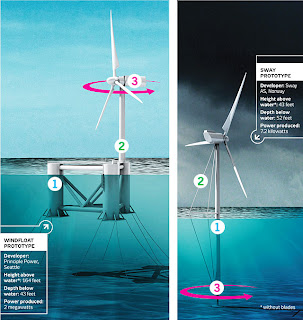Floating in the wind
 Back in late 1999 University of Massachusetts professor Jim Manwell called me in my office at the Massachusetts Renewable Energy Trust where I had recently started to work. Professor Manwell wanted to talk about offshore wind energy. He was concerned that none of our official documents identified offshore wind as a potential renewable energy source for the Commonwealth.
Back in late 1999 University of Massachusetts professor Jim Manwell called me in my office at the Massachusetts Renewable Energy Trust where I had recently started to work. Professor Manwell wanted to talk about offshore wind energy. He was concerned that none of our official documents identified offshore wind as a potential renewable energy source for the Commonwealth. This is when I first learned about Professor Bill Heronemus of UMass -- a former nuclear engineer who saw the light (and felt the wind) and became the university's first professor of wind energy. He was known the world over as the “father of modern windpower”. In the 1970s he wrote about the tremendous potential of the wind source flowing over the waters off the Atlantic coast -- which he estimated could power all of Massachusetts. Professor Heronemus also proposed that the wind turbines harvesting this energy should be floating. (GW)
Can Floating Turbines Save Wind Power?
Two new concepts for floating wind turbines put the future of wind energy out to sea.
BY Stephanie Warren
Popular Mechanics
December 22, 2011
The best place to build the wind farms of the future is the open ocean. While the breeze can be frustratingly variable on land, if you travel just 20 miles off the coastline, the wind blows at a consistent clip of around 33 feet per second.
But along most parts of the coastal United States, the ocean floor drops off quickly. That makes standard offshore turbines, the kind that are fixed to the sea bottom for stability, too expensive to be worth it. Two companies, Sway and Principle Power, are currently testing a new kind of technology to combat this problem: floating wind turbines.
Principle's turbine is called WindFloat; the company has a prototype currently working in the waters off Portugal. It sits atop a base formed by three pontoons anchored to the seafloor by cables. Its 240-ton nacelle (gear housing) turns to meet the breeze, the way a land-based turbine does.
Sway's prototype, operating in Norway, is more of a small tower. Its center of gravity lies below the structure's center of buoyancy, which lets it stay upright even in stormy seas. With Sway, the entire tower rotates to get in the best position to capture wind.
Though these prototypes are currently in Europe, the United States is keeping a close eye. The Department of Energy, which estimates that wind power could cover 20 percent of our energy needs by 2030, has contributed funding to both systems. The hope is that offshore wind power can alleviate some of the problems hampering that energy source in America now.
For instance, traditional wind farms are on land, many located in the Plains states. Although they can generate a substantial amount of power, the problem is transporting that power to the big cities that need it most, many of which are located hundreds of miles away in coastal areas.
By contrast, regular "fixed bottom" off-shore wind turbines are built close to the coast, within easy transport distance to large, power-guzzling cities. But they too have their cons, says Fort Felker, director of the National Wind Technology Center. For one, most residents of coastal towns simply don't want their ocean views interrupted by wind turbines. Another is that anchoring these wind turbines to the ocean floor is expensive and difficult, and the noise can disrupt marine animals. Two hundred feet is considered the maximum depth for fixed-bottom turbines, and two-thirds of the U.S. coastal ocean is deeper than this limit, Felker says.
Deep-sea offshore wind turbines have the potential to solve many of these problems. Their floating construction is ideal for the deep coastal waters of the U.S. And since they don't have to be fixed to the ocean floor, they can be assembled conveniently on dry land before they're launched (and it's possible that they can be pulled back in for repairs as well). Because the towers are far off-shore, they won't offend coastal residents, and they're perfectly positioned to take advantage of the open ocean's strong and steady winds.
The key to making floating wind turbines work is a design that collects enough energy to justify the cost of building and installing them. Luckily, experts say, the technology already has a head start: Offshore oil and gas drilling companies have long dealt with the engineering challenges of floating designs. "The challenge for the wind industry is to adapt these technologies and extract costs so that we end up with an efficient, renewable energy system," Felker says.
1. STABILITY
WindFloat's base adjusts the water level in three columns to keep the turbine level. Engineers designed Sway's tall, slender tower so that its center of gravity lies below the structure's center of buoyancy, allowing it to remain steady even when seas are turbulent.
2. AFFORDABILITY
WindFloat saves steel by placing its tower on a column instead of on a platform. The Sway design economizes and gains structural support with steel cables. Its blades are mounted downwind—the opposite of most turbines—to keep them clear of the cables.
3. ROTATION
WindFloat's 100-ton nacelle, or gear housing, turns to meet the breeze, like a typical land-based turbine. The Sway's entire tower rotates on a universal joint that connects the turbine to the tension-leg anchor; the blade clearance from the wires remains constant.

0 Comments:
Post a Comment
<< Home